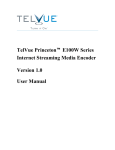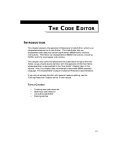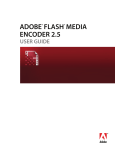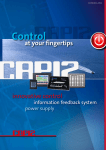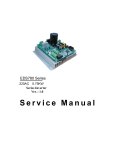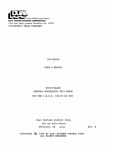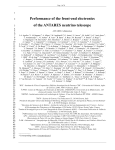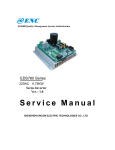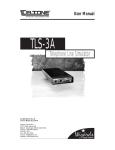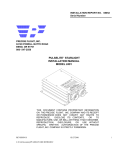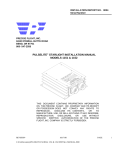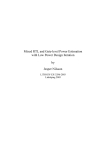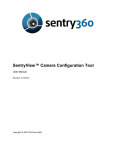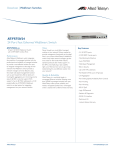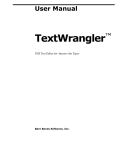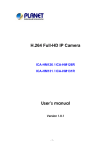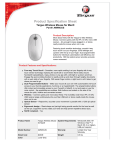Download "user manual"
Transcript
User Manual by Jamie Green Rebound! Designer Amar Singh Rebound! Software Richard Elmore Critical Mass Jonathan Feinstein Copyright ©1998 Sophisticated Circuits, Inc. All rights reserved. MANPKRB-0498 Service Requirements In the event of equipment malfunction, all repairs should be performed by our Company or an authorized agent. It is the responsibility of users requiring service to report the need for service to our Company or to one of our authorized agents. Service can be obtained at Sophisticated Circuits, Inc., PO Box 727, Bothell, WA 98041-0727, 425-485-7979. FCC Statement This equipment has been tested and found to comply with the limits for a Class B digital device, pursuant to PowerKey Rebound! PKRB-M Part 15 of the FCC Rules. These limits are designed to provide reasonable protection against harmful interference in a residential installation. This Tested To Comply equipment generates, uses and can radiate radio With FCC Standards frequency energy and, if not installed and used in accordance with the instructions, may cause harmful interference to radio communications. However, there FOR HOME OR OFFICE USE is no guarantee that interference will not occur in a particular installation. If this equipment does cause harmful interference to radio or television reception, which can be determined by turning the equipment off and on, the user is encouraged to try to correct the interference by one or more of the following measures: • • • • Reorient or relocate the receiving antenna. Increase the separation between the equipment and receiver. Connect the equipment into an outlet on a circuit different from that to which the receiver is connected. Consult the dealer or an experienced radio/TV technician for help. Shielded cables and I/O cords must be used for this equipment to comply with the relevant FCC regulations. Changes or modifications not expressly approved in writing by Sophisticated Circuits, Inc. may void the user’s authority to operate this equipment. Copyright Notice The PowerKey Rebound! documentation, program, product design and design concepts are copyright ©1998 Sophisticated Circuits, Inc. All rights reserved. Your rights are subject to the copyright laws of the United States of America. Under the copyright laws, this manual may not be copied, in whole or part, including translation to another language or format, without the express written consent of Sophisticated Circuits, Inc. Trademarks PowerKey is a registered trademark, and PowerKey Rebound! is a trademark of Sophisticated Circuits, Inc. Apple, AppleScript, Macintosh, Mac and Power Macintosh are registered trademarks, and Balloon Help, Finder and System 7 are trademarks of Apple Computer, Inc. PowerPC is a registered trademark of International Business Machines Corporation. Frontier is a trademark of UserLand software. Page 2 PowerKey Rebound! Introduction Thank you for purchasing PowerKey Rebound!™ Rebound! constantly monitors your Mac® system to make sure it is running normally. If the system crashes, Rebound! restarts it automatically. It also works with many popular server applications. Once you install Rebound!, you can sleep well, knowing your server will stay up and running! System Requirements Rebound! works with any Power Macintosh® desktop or server computer and later 68040 Macs that respond to the keyboard “command-control-power-on-key” restart command. Rebound! uses patent-pending technology from the PowerKey® Pro family of smart power strips to monitor your computer. If it crashes, Rebound! automatically sends the “command-control-power-on-key” signal to restart it. Older Mac models do not respond to this signal reliably, and must be physically turned off to be restarted. For these models, we recommend PowerKey® Pro with the Server Restart Option™. PowerKey Pro has the ability to turn off its outlets, effectively “pulling the plug” to restart your server. The Rebound! software requires System 7™ or later, and runs in native mode on both 68040- and PowerPC®-based Macs. It supports Balloon Help™, Apple Guide, Apple Events and AppleScript®. PowerKey Rebound! Page 3 Installation PowerKey Rebound! detects crashes using both hardware and software, working together. The software gives the hardware the feedback it needs to determine whether or not the system has crashed, so you must install both to use Rebound! Hardware Installation The Rebound! hardware was designed to connect directly to your computer’s Apple Desktop Bus (“ADB”) port (as labelled with the icon shown to the right). It has a pass-through connector allowing you to connect your keyboard (and possibly other devices) in a “chain”. (B) Page 4 (A) 1. Shut down your computer normally. 2. Disconnect your keyboard cable from the ADB port on the back of your computer. 3. Connect Rebound!’s short cable to the ADB port on the back of your computer (A). 4. Connect your keyboard cable into Rebound! (B). 5. Start up your computer normally. PowerKey Rebound! Software Installation 1. Insert the PowerKey Rebound! disk into your floppy drive, and double-click the icon labelled “Installer.” The Installer window will open. 2. Make sure your startup disk is shown in the Destination Disk panel. If it is not, click the Switch Disk button until it is shown. 3. Click Install. The Installer will ask if it can quit any open applications before it begins. Make sure you don’t have any unsaved documents, then click Continue. When the installation is complete, the Installer will restart your computer. Rebound! starts watching for system crashes as soon as your computer has finished restarting. The next section shows you how Rebound! works, and how you can change its settings. PowerKey Rebound! Page 5 Using Rebound! As soon as you finish installing PowerKey Rebound!, it will begin monitoring your system for crashes. Rebound! is designed to work unobtrusively in the background: You will never see any sign that it is working until your system crashes! The Rebound! Control Panel Rebound!’s default configuration should work in most systems, but you can customize its settings using the Rebound! control panel. This control panel is installed in the Control Panels folder, and can be accessed from the Apple menu. Page 6 PowerKey Rebound! Enable System Crash Detection If this box is checked, Rebound! will monitor your system and attempt to restart it if it detects a crash. Uncheck this box to turn Rebound!’s system crash detection off. The Rebound! hardware monitors your system by periodically communicating with the Rebound! software. When the system crashes, this communication will stop, and the Rebound! hardware sends the keyboard “command-controlpower-on-key” signal to restart it. It is a good idea to uncheck this box before doing any unusually processor-intensive task, such as long calculations or file copies on some systems. See “Restart if system doesn’t respond” below for more information. Restart if system doesn’t respond This slider lets you set how long the Rebound! hardware will wait before deciding that the system has crashed. If an application runs certain long uninterruptible tasks, the normal communication between the Rebound! software and hardware can be temporarily stopped. To keep from interpreting these pauses as crashes, you can set this slider to a higher waiting time. Be careful not to set this waiting time too low. The lower the waiting time, the more likely a long task will be interpreted as a crash. Time allowed for system to restart This slider lets you set how long the Rebound! hardware will wait to reestablish communication with the software after a restart. PowerKey Rebound! Page 7 Normally, the Rebound! software reestablishes communication as the system finishes restarting. If the system crashes again during restart, the Rebound! software won’t be able to do this. If the Number of restart attempts slider (see below) is set to a value higher than “1,” the hardware will wait for the computer to finish starting up. If the Rebound! software doesn’t respond within this time, the hardware will attempt to restart the computer again. Number of restart attempts This slider lets you set the number of times the Rebound! hardware will attempt to restart the computer if it crashes again during the restart process. This feature works in conjunction with the Time allowed for system to restart slider above. After detecting a crash and restarting the system, the Rebound! hardware will wait for the Rebound! software to reestablish communication, signifying a successful restart. If this doesn’t happen within the time allowed, the hardware can try again up to four more times. For most purposes, this slider should remain at 1. If your computer often requires multiple restart attempts, it usually signifies that something is wrong with your system, and overall reliability is reduced. Enable Application Crash Detection If this box is checked, Rebound! will monitor applications which include Rebound! support. See “Detecting Application Crashes” on the next page for more information. Page 8 PowerKey Rebound! Detecting Application Crashes Sometimes it is possible for an application to crash, allowing other applications and the System software to keep running. Since the Rebound! software continues to communicate in this situation, no crash will be detected. Rebound! includes the ability to monitor applications which have Rebound! support written into them. An application with Rebound! support periodically communicates with the Rebound! software. If this communication fails, Rebound! can restart the computer. If any running applications with Rebound! support crash, the Rebound! software will attempt a Finder “Restart” command. If that fails, the Rebound! hardware will attempt a “command-option-power-on-key” restart a few minutes later (as determined by the Restart if system doesn’t respond slider). The amount of time that Rebound! will wait for communication to resume is set by each application. See your application’s user manual for more information. A list of applications which support Rebound! can be found on our web site at <http://www.sophisticated.com/>, or check with your application’s developer to see if they support Rebound! If you wish to monitor an application that does not support Rebound!, you can install the “Macsbug” debugging tool in your system folder. Macsbug will cause any application crashes to completely halt the system, just like a system crash. Rebound!’s system crash detection will then restart the computer. Macsbug is available at no cost from Apple’s web site at <http://www.apple.com/> (search for “Macsbug”). No special configuration of Macsbug is necessary; simply drop it into your System Folder and restart your computer. PowerKey Rebound! Page 9 Using Rebound! with AppleScript Advanced users can control all of Rebound!’s features with AppleScript or any other OSA-compliant scripting language (such as UserLand Frontier™). To change Rebound!’s settings, place a tell block in your script as follows: t e l l application “Rebound! Extension” ... end tell Application Properties The Rebound! Extension contains several properties which can be read or modified. These properties correspond to the settings in the Rebound! control panel. version Version of the Rebound! software sysTimerEnabled Set to true or false to enable or disable system crash detection crashDetectionTimeout Value of the “Restart if system doesn’t respond” slider, in seconds restartInterval Value of the “Time allowed for system to restart” slider, in seconds restartCount Value of the “Number of restart attempts” slider appTimersEnabled Set to true or false to enable or disable application crash detection You can examine and modify these values by using AppleScript’s get and set commands. For example, to change the value of the “Restart if system doesn’t respond” slider to ten minutes, execute the following command inside your tell block: s e t crashDetectionTimeout t o 600 It is possible to set values between or outside the marks on the control panel’s sliders, but they will snap back the next time the user modifies them from the Rebound! control panel. Page 10 PowerKey Rebound! AppTimer Elements Rebound!’s application crash detection works by creating appTimers for each application being monitored. Each application sets its appTimer periodically to keep it from reaching zero. If an appTimer does reach zero, Rebound! assumes the application has crashed and restarts the system. You can use Rebound!’s application crash detection to monitor custom scripts, databases or applications you have written. To do this, your application should periodically send a tickleAppTimer AppleScript command: tickleAppTimer 300 The Rebound! software will automatically create a new appTimer for your application if necessary, and repeated commands will update that timer. You can also set your appTimer with a simple Apple Event, bypassing AppleScript. Use Event Class ‘PKPr’ and Event ID ‘Tick’, and put the desired value as a long integer into the direct object parameter. applications will usually not need to view appTimers themselves, but if you do wish to do this, you can deal with them like any other element of an application. AppTimers have name and value properties. You cannot set the properties of an appTimer, but you can get them. To set your appTimer, use the tickleAppTimer command described above. g e t name o f e v e r y appTimer g e t value o f appTimer “My Application” For development information on supporting Rebound!, see the PowerKey Software Developer’s Kit on our web site at <http://www.sophisticated.com/>. PowerKey Rebound! Page 11 Testing Rebound! Testing System Crash Detection You can test Rebound’s system crash detection without waiting for an actual crash. To simulate a crash, simply hold down the command (1) key and press the power-on key. A small window will appear with nothing but a ‘>’ symbol in it. This window is the Mac’s built-in mini-debugger, and while it is open, no other software can run. In a few minutes, Rebound! should think the computer has crashed and restart it. There are also several test applications available which purposely cause a variety of system crashes. We offer one called “Crash Test,” which is available on our web site, <http://www.sophisticated.com/>. Some crash utilities purposely quit all applications while crashing. These utilities have less real-world validity (real crashes aren’t so polite), and actually disable some crash detection tools, including Rebound! The Rebound! software will display a warning dialog if another application attempts to make it quit. Testing Application Crash Detection To simulate a crash in an application with Rebound! support, bring that application to the foreground and type command-option-escape. You will be asked if you wish to force the application to quit; click Force Quit. Since the application wasn’t able to quit normally, its Application Timer will continue counting down. In a few minutes, Rebound! should think the application has crashed and perform a Finder restart. If that fails, it should try a hardware restart a few minutes after that. Page 12 PowerKey Rebound! Troubleshooting Using Rebound! with PowerKey Pro Because Rebound! uses the same crash detection technology as PowerKey Pro, the Rebound! software cannot run while the PowerKey software is running. The PowerKey software allows you to configure Rebound! from within the PowerKey Editor. The Rebound! software will disable itself if it detects the PowerKey software running at startup. See the “READ ME — PowerKey Pro” document on the PowerKey master disk or updater for information on controlling Rebound! from the PowerKey software. Rebound! is supported in version 3.4 or newer of the PowerKey software. You can download a free updater on our web site, <http://www.sophisticated.com/>. Using Rebound! with Monitor/Keyboard Switches Rebound! must be able to remain connected to your computer’s ADB port constantly to detect crashes. If you wish to use Rebound! in conjunction with a monitor/ keyboard switching unit, you must place Rebound! directly into the computer’s ADB port. We have found some switching units which do not implement ADB correctly. If any other ADB device, including Rebound!, is used with one of these switches, the mouse and keyboard may appear “frozen” after startup. The computer is still running, but the switch stops reporting mouse and keyboard activity. The monitor switching capabilities of these devices will not cause these problems, and can be used in conjunction with Rebound! PowerKey Rebound! Page 13 Common Problems and Solutions Rebound! doesn’t restart my computer after the system crashes. Some crashes which appear to be system crashes are actually caused by applications. Though the system may be unresponsive, other processes are still running normally. See “Detecting Application Crashes” on page 9 for more information. Rebound! doesn’t restart my computer after an application crashes. An application must be specifically written to support Rebound!’s application crash detection. Contact your application’s developer to see if they offer Rebound! support. You can use Macsbug to cause many application crashes to become system crashes. See “Detecting Application Crashes” on page 9 for more information. An error message appears at startup every time Rebound! restarts my computer, saying the computer was shut down improperly. This is a standard message that appears in some versions of Mac OS after a crash occurs. You can disable this message in the General Controls control panel. Uncheck the box labelled “Warn me if computer was shut down improperly.” Rebound! restarts my computer when I run some applications. Some long operations will take control of the computer, and not give time to any other processes, including the Rebound! Extension. The Rebound! unit interprets this as a crash. Raise the value of the Restart if system doesn’t respond slider. Some applications, including some disk utilities and games, will take control of the computer for very long times. If you need to run one of these programs, you should temporarily uncheck Rebound!’s Enable System Crash Detection box. Page 14 PowerKey Rebound! Index A ADB port 4, 13 Apple Events 11 AppleScript 10 appTimer elements 11 properties 10 Application crashes 9, 14 C Crash Test 12 D Detecting crashes application crashes 8, 9 system crashes 7 E Enable Application Crash Detection check box 8 Enable System Crash Detection check box 7 F Force Quit 12 Frontier 10 G General Controls control panel 14 I Improper shut down warnings 14 Installation hardware 4 software 5 PowerKey Rebound! K Keyboard switches 13 M Macsbug 9, 14 Mini-debugger 12 Monitor/keyboard switches 13 N Number of restart attempts slider 8 P PowerKey Pro 3, 13 R Rebound! control panel 6 Restart if system doesn’t respond slider 7 Restart keystroke 3 S Server Restart Option 3 System crashes 7, 14 System requirements 3 T Testing application crashes 12 system crashes 12 Time allowed for system to restart slider 7 Troubleshooting 13, 14 Page 15 How To Reach Us Mailing: Sophisticated Circuits, Inc. PO Box 727 Bothell, WA 98041-0727 Shipping: Sophisticated Circuits, Inc. 18618 129th Ave NE Bothell, WA 98011 Phone: Voice: 425-485-7979 Fax: 425-485-7172 Internet: Web: http://www.sophisticated.com/ FTP: ftp://ftp.sophisticated.com/ e-mail: [email protected], [email protected], [email protected] Page 16 PowerKey Rebound!


















